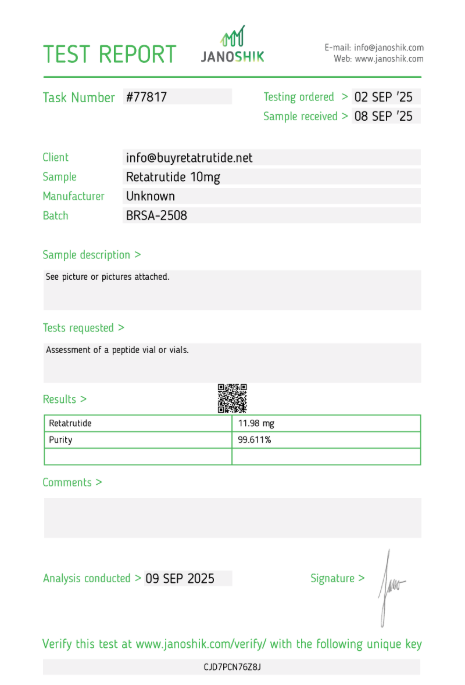How does Retatrutide work? A clear UK guide to the “triple-agonist” weight-loss drug
20 August 2025Retatrutide Order Online: Sourcing, Supplier Verification, Logistics
3 September 2025UK price shock drives Retatrutide buzz
The media spotlight on Retatrutide intensified after news broke that Mounjaro (Tirzepatide) prices in the UK will rise sharply from 1 September 2025. Private prescriptions could increase to over £300 for higher doses, fuelling both stockpiling and debate. With Mounjaro’s rising cost, many outlets are speculating whether Retatrutide could be the next-generation alternative.
Important context: this is narrative hype, not fresh scientific data. Retatrutide’s phase 2 results already showed impressive average weight reductions of ~24% at 48 weeks, but there has been no new clinical trial release in recent weeks.
Retatrutide vs Mounjaro — the numbers
- Retatrutide (phase 2, 48 weeks): ~24.2% mean weight reduction at higher doses.
- Mounjaro (SURMOUNT‑1, 72 weeks): ~20.9% mean reduction at 15mg, with some arms reaching ~22.5%.
While Retatrutide’s numbers appear stronger, direct comparison is not yet valid—different trial designs, durations, and populations make it premature to declare a winner. Phase 3 trials for Retatrutide are still ongoing and expected to read out in 2026.
Eli Lilly’s $1.3B AI investment — ecosystem signal
Beyond Retatrutide itself, Eli Lilly has committed $1.3 billion in a partnership with Superluminal Medicines to accelerate AI‑powered obesity and cardiometabolic drug discovery. While not Retatrutide-specific, this investment underscores Lilly’s long-term strategy to dominate obesity care, including possible oral and next-generation agents. It strengthens the broader ecosystem that supports molecules like Retatrutide.
Competition on the horizon: PN‑477
Protagonist Therapeutics has announced PN‑477, a triple‑agonist targeting GLP‑1, GIP and glucagon, positioned as both oral and injectable. First‑in‑human trials are expected in Q2 2026. This marks the first clear future rival for Retatrutide and signals that the triple‑agonist space will be competitive.
What this means right now
- For patients: Mounjaro’s UK price increases are real; Retatrutide is still investigational. Don’t expect near‑term access.
- For clinicians: Stay focused on approved options (Wegovy, Mounjaro) while monitoring upcoming phase 3 Retatrutide results.
- For investors: Lilly’s $1.3B AI deal and PN‑477’s nomination point to a rapidly evolving obesity drug landscape, with Retatrutide at the centre of the narrative.
Straight talk
Right now, the story is media momentum, not scientific breakthrough. The UK price shock for Mounjaro has triggered hype, but the underlying Retatrutide data hasn’t changed. What has changed is the strategic ecosystem: Lilly is doubling down on R&D, and new rivals like PN‑477 are emerging. Retatrutide remains one of the most promising molecules in the pipeline, but the next real milestone will be its phase 3 readouts, expected in 2026.
Frequently Asked Questions (FAQ)
How does Retatrutide compare to Mounjaro?
Retatrutide’s phase 2 data showed ~24% mean weight loss at higher doses, while Mounjaro’s SURMOUNT-1 trial showed ~20.9%. These are not directly comparable as the trials differ in length and design.
Is Retatrutide available in the UK?
No, Retatrutide is still in clinical trials. Phase 3 results are expected in 2026. It is not yet available on the NHS or private prescription.
What makes PN-477 a competitor to Retatrutide?
PN-477 is a triple agonist (GLP-1, GIP, glucagon) being developed by Protagonist Therapeutics. It’s expected to begin trials in 2026 and could compete directly with Retatrutide if successful.
Why is there hype about Retatrutide right now?
The recent rise in UK Mounjaro prices has triggered media speculation that Retatrutide may be a next-generation alternative. However, there is no new trial data—just media buzz.
This article is for information purposes only and is not medical advice. Always consult a healthcare professional about your personal situation.
